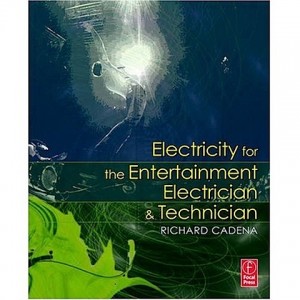 We ran a trivia contest last week to win a copy of Richard Cadena’s latest book, Electricity for the Entertainment Electrician & Technician. The winning answer was posted in record time of 18 hours after the contest began. Tom Baldwin of Hampshire (UK) had the winning answer with a detailed explanation of why.
We ran a trivia contest last week to win a copy of Richard Cadena’s latest book, Electricity for the Entertainment Electrician & Technician. The winning answer was posted in record time of 18 hours after the contest began. Tom Baldwin of Hampshire (UK) had the winning answer with a detailed explanation of why.
The resistance of a lamp varies with temperature.
So it’s not as simple as using Ohm’s law to work out the resistance from 575W @ 115V and recalculate for 120V.
On a 120V supply, the lamp will burn hotter, and so its resistance will be lower. This means that the current flowing will be greater than the naive calculation assumes.
In practise, the easiest way to determine the current at 120V would be to simply measure it.
To predict the current, it would be necessary to measure the operating current at a number of voltages, and to plot a curve of filament resistance versus applied voltage. From this curve the operating current at any given voltage could be extrapolated (or interpolated).
By using a mathematical fitting function to map the measured points on the graph back to a mathematical function, this prediction could be made without recourse to graph paper.
There are, of course, ready reckoning tables, which would allow the current change for x% increase to be roughly estimated.
And after all that writing, the real answer is that there can be very few circumstances where the change in operating current between 115V and 120V really matter!
We congratulate Mr. Baldwin on a job well done! To purchase your copy of the book, visit the PLSN Bookshelf at www.plsnbookshelf.com
LatestHeadlines
- Upgrading Your Toolbox: City Theatrical DMXcat-E and DMXcat Multi Function Test Tool
- Claypaky Bringing Back the Sexy to Par Cans with the Midi-B FX
- Ayrton Evolves the Cobra, the Cobra2 Developed for the US Market
- MA Lighting Intros grandMA3 onPC Fader Wing and DIN-Rail Nodes
- Live Events LEVL Up Fest: A Festival to Aid our Industry